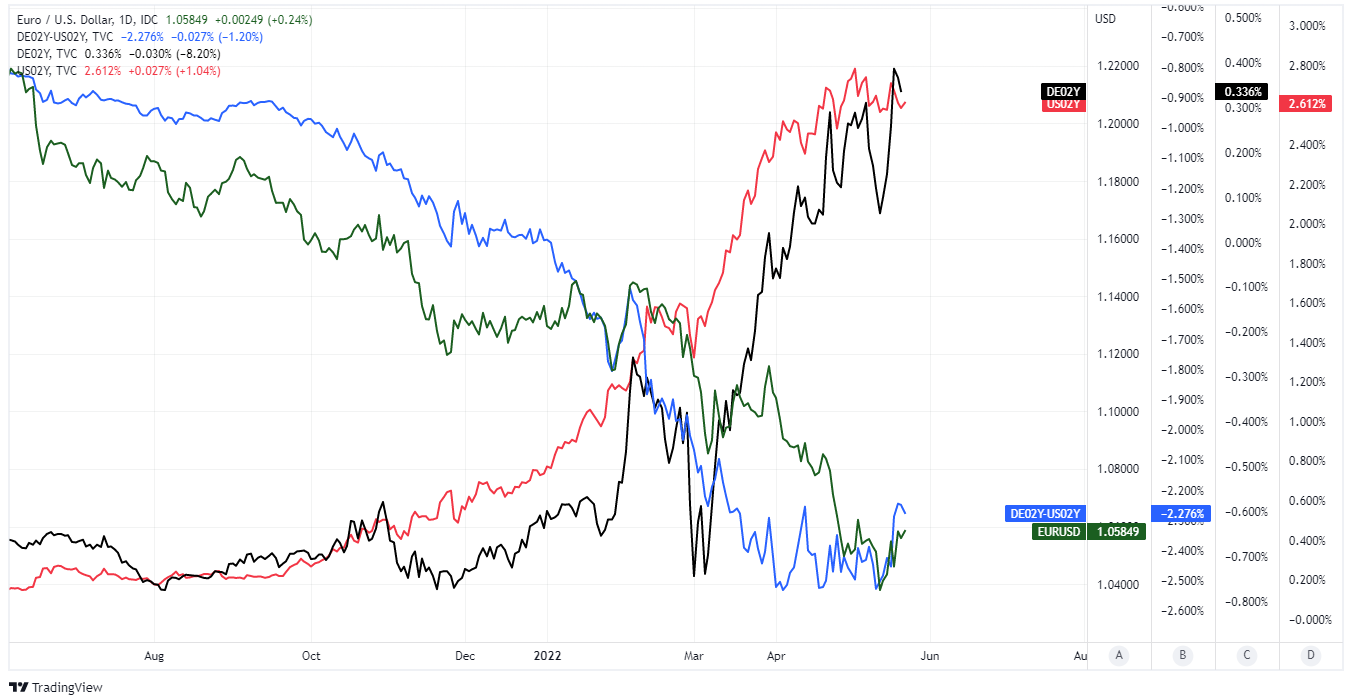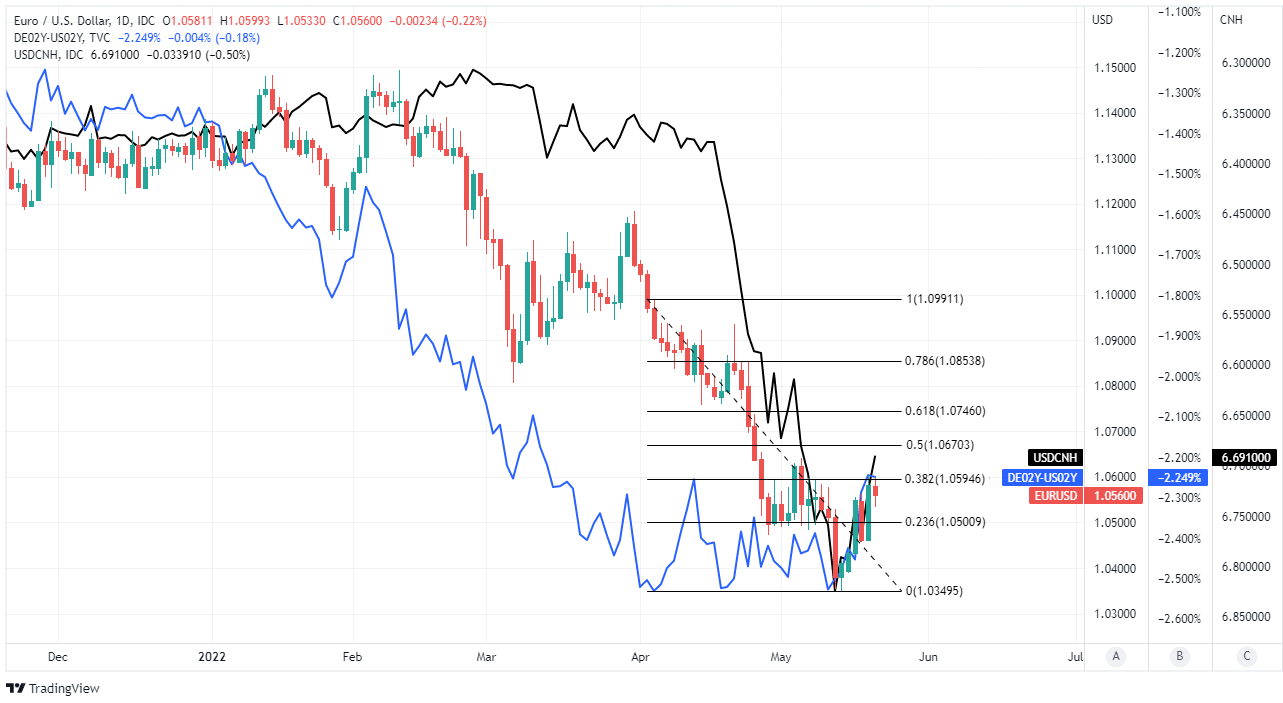EUR/USD Week Ahead Forecast: Test of 1.0670 Could be Seen
- Written by: James Skinner
-
- EUR/USD rebound could extend as far as 1.0670
- If USD consolidation continues & RMB pares loss
- ECB policy stance also helping support EUR/USD
- Eurozone PMI surveys, USD & RMB trends eyed

Image © European Union - European Parliament, Reproduced Under CC Licensing.
The Euro to Dollar rate has turned from five year lows and could now attempt to recover further if the U.S. Dollar continues a nascent consolidation and the Renminbi remains on a firmer footing, although many analysts are apprehensive about Eurozone economic figures due out in the week ahead.
Europe’s single currency has benefited in recent trading from ebbing U.S. bond yields, a softer U.S. Dollar, a sharp rebound by the Renminbi and a growing choir of hawkish European Central Bank (ECB) policymakers whose remarks have lifted Eurozone bond yields notably in the last week.
Governing Council members are increasingly unanimous in their suggestion that the ECB could begin lifting its negative deposit rate for the first time since 2011 in the near future and potentially as soon as July in order to help rein in Eurozone inflation rates.
President Christine Lagarde reportedly reiterated that message on Dutch television at the weekend where she echoed sentiments expressed on May 11 at a Bank of Slovenia conference in what is a further supportive outcome for Eurozone government bond yields.
“During the past week softer survey data in the US have driven the USD lower, and the 50bp comment from the ECB’s Knot has driven EUR/USD higher,” says Jordan Rochester, a strategist at Nomura, writing in a Friday research briefing.

Source: Nomura.
“Next week it is the turn of Europe’s growth surveys to drive price action, with Germany’s Ifo, flash PMIs and consumer confidence surveys for May. We suspect EUR/USD will push lower once again,” Rochester also said before suggesting that Nomura clients continue to bet against EUR/USD.
Recent commentary from ECB officials has prompted financial markets to fully price-in a July rate rise from the bank and to also wager with increasing confidence that it could be likely to follow up that move with a series of additional rate steps before year-end.
Coming against a backdrop of easing U.S. bond yields and a softer U.S. currency this has been highly supportive of the Euro-Dollar rate in recent trading, although Nomura’s Rochester and others argue that Eurozone economic figures will be key for the Euro this week. (Set your FX rate alert here).
“The EUR-USD managed to pull back close to 1.06 on hawkish ECB remarks and despite tumbling US stocks and tighter interest rate differentials with the US. Upcoming data releases, however, will likely thwart these recovery attempts again,” says Roberto Mialich, an FX strategist at UniCredit.
“We expect both PMI surveys across the eurozone and the Ifo business climate in Germany to mark another mild deterioration compared to more stable new US data releases,” Mialich also said in a Friday note to clients.
Above: Euro Dollar rate shown at daily intervals alongside spread or gap between 02-year German and U.S. government bond yields as well as individual 02-year German and U.S. government yields. Click image for closer inspection.
Tuesday’s IHS Markit PMI surveys are the domestic highlight of the week ahead for the Euro and will be scrutinised closely by the market.
Many will be looking for clues on how Europe’s largest companies have coped with the continued commodity price fallout from Russia’s invasion of Ukraine and supply chain disruption connected to an April 05 ‘lockdown’ of the world’s largest port city, Shanghai, in China.
“Europe’s economy has been surprisingly resilient from the energy shock. China may be in the early stages of re-opening, starting with Shanghai. An improved outlook for the world economy, if sustained, will pull the USD down,” says Joseph Capurso, head of international economics at Commonwealth Bank of Australia, writing in a Monday look at the week ahead.
“EUR/USD can also continue to lift further off its recent lows this week in line with the weaker USD. Expansionary readings for the May German IFO (Monday) and Eurozone flash PMIs can support EUR. The PMIs for March and April remained expansionary despite high energy prices, and uncertainty around the war and Russian gas supply,” Capurso and colleagues added.
While the May PMI surveys remain to be seen, the Euro could also benefit this week if China’s Renminbi remains on a firmer footing and further pares back some of the losses sustained since the shutdown of Shanghai.
Above: Euro to Dollar rate shown at daily intervals with Fibonacci retracements of April 05 fall indicating likely technical resistances. Featured alongside inverted or upside down Dollar-Renminbi exchange rate as well as spread - or gap - between 02-year German and U.S. government bond yields. Click image for closer inspection.
A further Renminbi rebound is a possibility, if not a likelihood after the Peoples’ Bank of China (PBoC) also cut its mortgage-linked interest rates last week just as Shanghai began a phased reopening that could see China’s foreign trade and manufacturing activities normalise in June.
“The property sector accounts for 30% of the Chinese economy – so yes, this is a big deal and much needed given sagging private sector demand, falling prices and developer defaults,” says Bipan Rai, North American head of FX strategy at CIBC Capital Markets
“For now, we envisage EUR/USD trading within the 1.0340-1.0640 range,” Rai and colleagues said in a Friday market commentary.
Anything that supports a Chinese economic recovery or normalisation of the country’s foreign trade would be noteworthy for the Eurozone given that 10% of the bloc's exports went to the world’s second largest economy in 2021, which was also the source of 21% of Eurozone imports.
This may be why the Euro was adversely impacted last month as the Renminbi slumped in the wake of the now-easing Shanghai shutdown.
Any further Euro-Dollar rebound would see the 1.0670 level coming into focus, which marks the 50% retracement of the single currency's decline from April 05.








